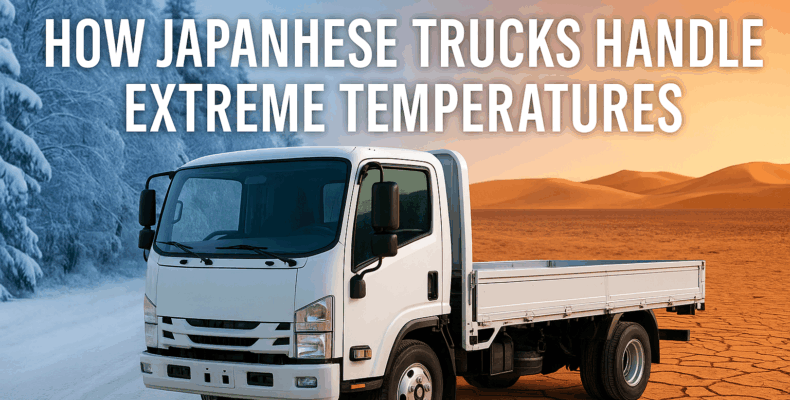How Japanese Trucks Handle Extreme Temperatures
Japanese trucks are known worldwide for their durability, versatility, and advanced engineering. But how do they perform in the harshest climates — from the freezing tundra of northern Canada to the blistering heat of the Middle East or Africa?
In this article, we explore how Japanese trucks are designed to thrive in extreme temperature conditions. We also introduce trusted exporters who can help you find the perfect model for your environment.
❄️ Built for Cold: Reliable in Sub-Zero Conditions
In cold regions, trucks often struggle with frozen engines, sluggish batteries, and brittle materials. However, Japanese manufacturers like Hino, Isuzu, and Mitsubishi Fuso design their vehicles to withstand these conditions.
Here’s how they do it:
-
Cold-resistant materials in engine parts and seals prevent cracking.
-
High-capacity batteries retain charge even in sub-zero temperatures.
-
Block heaters and glow plugs ensure easy cold starts.
-
Advanced fuel injection systems reduce startup time and improve efficiency.
Thanks to these features, Japanese trucks are used successfully in snowy regions like Hokkaido and northern Europe.
☀️ Engineered for Heat: Performance in Desert Climates
Conversely, Japanese trucks are also used in some of the hottest countries on Earth, including those in Africa, the Middle East, and Southeast Asia.
So, what makes them heat-resistant?
-
Oversized radiators improve cooling during long drives in hot weather.
-
Turbocharged diesel engines are tuned to reduce overheating risks.
-
Heat-resistant electrical systems prevent wiring failures.
-
Reliable air conditioning units support driver comfort and focus.
These trucks operate effectively in desert environments where daytime temperatures often exceed 40°C (104°F).
🛠️ Maintenance-Friendly Design in Harsh Environments
Extreme temperatures accelerate wear and tear. That’s why Japanese trucks are built with easy maintenance in mind.
For example:
-
Modular components allow for quick part replacement.
-
Diagnostic systems identify issues early.
-
Dust filters and water separators protect internal systems in dry or humid regions.
Furthermore, their global popularity means that parts and service are widely available — even in remote areas.
🌍 Tested in Japan, Proven Worldwide
Many Japanese trucks are tested under simulated climate stress before being released. Manufacturers use cold chambers and heat tunnels to mimic real-world conditions.
That’s why they are trusted by logistics companies, NGOs, construction firms, and humanitarian missions across the globe — especially in countries where the weather is the biggest challenge.
🔍 Looking to Import? Choose from the Best Exporters
Importing a truck built for your climate starts with choosing the right exporter. The following companies are known for high-quality service, excellent customer reviews, and transparent export processes:
-
Every Co., Ltd.
-
Trust Co., Ltd.
-
Be Forward
-
PicknBuy24
-
Car From Japan
They offer wide inventories and support across multiple countries.
👉 Check them out here:
Top 5 Trusted Japanese Used Truck Exporters for Global Buyers
✅ Final Thoughts
No matter where you operate — in snow-covered mountains or blazing deserts — Japanese trucks offer the durability, fuel efficiency, and climate adaptability that businesses need.
They are not just machines; they are solutions. With proper specs and the right exporter, you can enjoy smooth performance even under extreme weather stress.
Start your search today and invest in a vehicle that’s built to endure.
Reliability begins with Japan.
